I hope this finds all of you settled in and preparing for the upcoming spring season with your greenhouses and fundraisers. The challenges this year have been incredible in so many ways, especially with all of us still dealing with Covid issues and policies. With the increased demand for horticultural products and plants, there are a lot of growing pains that have reared their heads in trying to accommodate the demand. With shortages of plants and delayed production of horticultural supplies, the stress levels have been quite high. This was indeed the year to get your orders in early for both plants and supplies. Please make notes for next year.
Compounding these issues was that nasty cold snap and blizzard that held up plant orders (both incoming bare root material and outgoing rooted plants) and froze many shipments while delaying many others. Growers are still struggling to catch up. FedEx fell behind and is still not yet back to their A-game. If they were shipping auto parts all would be good but with plants, there is little room for delay or miscalculation.
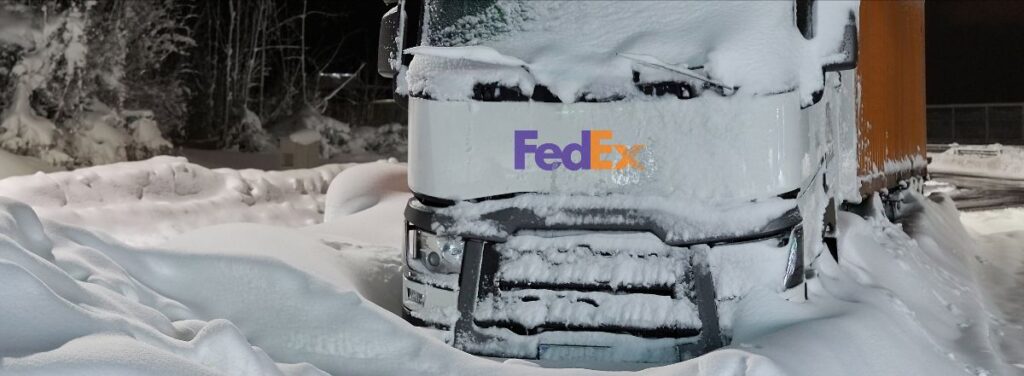
This should really be a wake-up call to our country… just how brittle our day-to-day operations are, and vulnerable to weather, computer hacking, and in general lack of security to the point where our World-Wide network can be shut down. This should be a wake-up call for all to be cautious and do more to have regional and local controls of sources, energy and food.
It will feel good to have everything finally in the greenhouse and on its way to spring! Now that we’re actively growing our plants, I’m once again getting questions regarding irrigation and associated fertilization that is so crucial to the successful cultivation of fast-growing annuals.
My first “part-time” job in a production greenhouse took place when I was in college and working about 60 hours a week with a full course load. The range was an old cut-flower range that dated back to the early 19th century where roses, gladiolas, and snapdragons were the primary crops. We were in the process of converting it to potted plant production at the time. Watering was almost all manual at that time so constantly wet feet were part of my daily routine. There was an old-timer on staff, Charlie, who watched me, with amusement, water on my first day for about 10 minutes, before stepping in to show me the proper techniques and impress on me that “the man with the hose grows the rose”. I heard this phrase several times again since then and it is indeed so true how proper watering can make or break a crop.
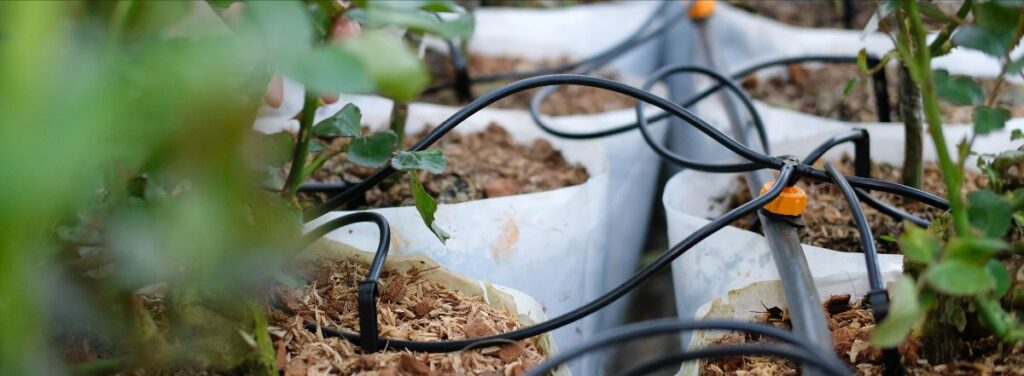
More decisions regarding irrigation are made each day throughout the crop cycle, more than any other which must be made correctly to make a uniform crop as well as stronger and healthier plants. Healthy plants are more resistant to diseases, insect pests, and the occasional dry spell. You can also control plant height with disciplined watering. As most of you know, with too much water and too little space tomatoes can rocket up and become spindly almost overnight.
Watering is difficult to monitor for an AG Teacher with multiple responsibilities, going in so many different directions simultaneously. When to water is based on many criteria. And what works this week may not work next week with the crops maturing and daytime temperatures increasing, watering schedules will evolve as well.
Then there is the variety of plant material being grown with each asking for their own preferred schedules and moisture needs. In most cases, you cannot meet the exact needs of each and every plant in a school-type setting, but you can arrive at a compromise that works for most. Some are “water hogs” that need much more water than most others that seem to require much less. Verbena and geraniums can require much more water than New Guinea Impatiens and other less robust varieties.
To grow any crop successfully, you must observe your plans as much as possible. If you see a thirsty plant you should feel thirsty, too. “Be one with the plant” is the mantra I always followed. Try to observe both in the morning and afternoon as a lot goes on between the two. Proper irrigation decisions target a balance between too dry and too wet which is not always easy to accomplish especially while, as most of you are, on the run.
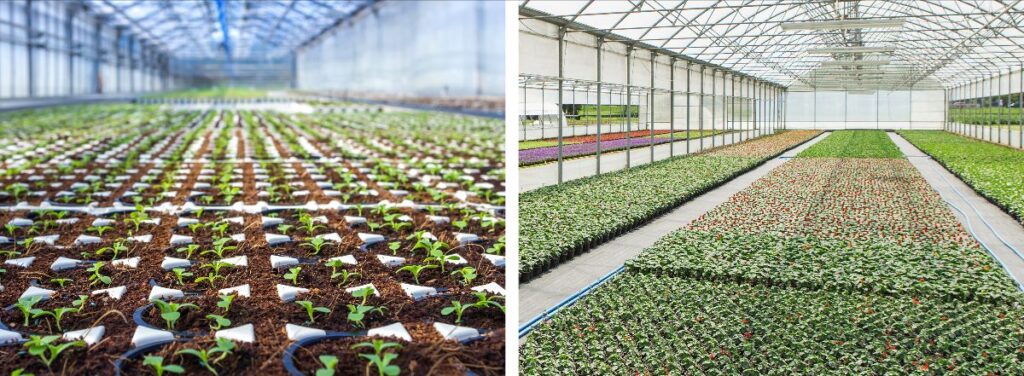
What affects a watering schedule?
- Maturity of a plant (newly planted cutting compared or mature and “ready for sale”)
- Type of plant (New Guinea Impatiens requiring less water vs Verbena requiring more)
- Time of year which affects greenhouse temperatures, sun intensity and length of day all affect transpiration
- Soil type: peat-based mix which holds more water longer vs a bark-based mix that is more porous, thus requiring more frequent watering.
- Container size and dimension both affect watering needs. Taller standard pots will dry quicker than shallower, pan-type containers. To illustrate this, take a regular sponge, soak with water and hold horizontally. Not a whole lot of drainage….? Now move the sponge to a vertical position and watch what happens….!
- Location in the greenhouse, amount of air movement as well as exposure to light or shade are all going to affect the amount of water that your plants require.
So, when should I water?
- The answer here is always changing and is a balance, influenced by all the above. The goal is constant moisture (much different than “constant wet”), not unlike the Goldilocks principle where the porridge is “not too hot nor too cold but just right.” This is not always an easy goal but there are clear indicators.
- The weight of the container before and after watering says a lot. In a small greenhouse setting, this is probably the easiest way to determine watering needs. Most soil mixes will hold seven to ten times their dry weight in water. Container weight is an easy means by which to tell whether water is needed.
- Color of the soil medium indicates the same. Soils are much lighter in color when dry and shift to a dark brown when hydrated.
- Wilting leaves are probably the most obvious symptom of thirsty plants but please keep in mind this may not always be the case. While they will wilt when dry, some will also wilt on the first sunny day following a prolonged cloudy period. It takes a while for the vascular system of some plants to wake up after becoming lazy in overcast weather where they didn’t have to work as hard. Watering here may prove detrimental. Also, wilting leaves may be indicative of bad roots. Popping the plant out of the pot and observing the root system will quickly confirm this or rule it out.
- Leaf “shine” indicates hydrated plants. This is hard to fully understand without observing them with that dull, non-gloss finish when becoming thirsty. Hydrated leaves have a shiny “glow”. When dry or just about dry, many lose that luster which is the last step before wilting. This is their way of conserving water by not bringing moisture to the surface of the leaves. Again, to perceive this one does need to be observant.
- In summation, when to water becomes a compromise in many cases especially with a lot of different plants treated as one. Some get a bit more water than needed and some a bit less, which is fine with a good quality soil mix providing air to the roots. It is the long-term effects that will cause damage to your crops if consistently watering too much or too little. Fortunately, most plants are very resilient and with relatively short-term crops such as spring annuals, this compromise usually works quite well.
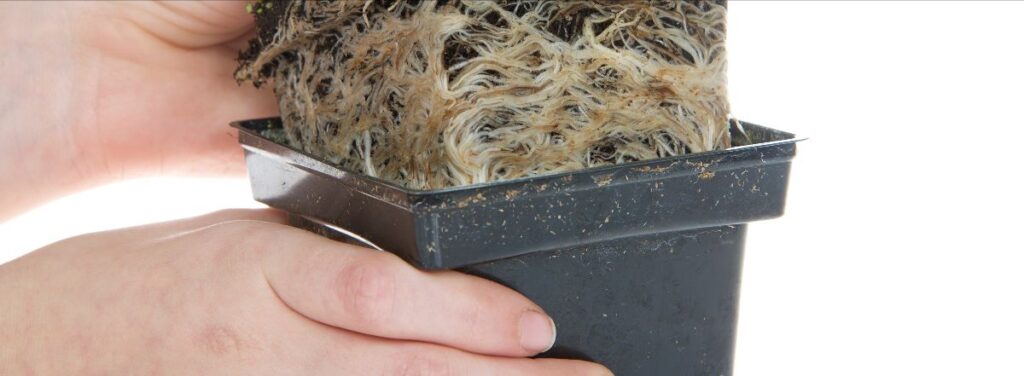
General rules for watering are surprisingly few and relatively easy to adhere to.
- Try to water in the morning, especially in cloudy weather or winter months. This allows all day for plants to take up the water and make the most of the day’s sunshine.
- When you do water, water thoroughly, letting water drain from the bottom of the container. This can be difficult to do if untrained students are watering, or if one is in a hurry or distracted. Water must get to all roots which means at the very bottom as well. This also allows some of the fertilizer salts to be leached out thus avoiding salt damage to the roots.
- Ideally, fertigation with each watering is best for overall plant health. Like people, plants need to eat. Their meals should be provided consistently for best results, rather than being rationed out once a week or on an arbitrary schedule which too often reflects convenience on our part rather than the well-being of the plant.
I understand the above would be much easier for a grower to accomplish due to the focus of plant health and a profitable crop being pretty much the extent of a grower’s job description. As AG Teachers, you have this obligation as well as a plethora of other duties throughout the day, nights, and even weekends. Proper watering is indeed a developed skill that requires constant observation and focus. Students, while meaning well, can be either helpful or detrimental depending on their training and “focus” while handling the watering wand.
Hand watering and manually turning on valves is good as you can “inspect” plants as you water. Dry spots, diseases, insects, and other growth issues are easily found as you make your way through the crop. But watering by hand is also time-consuming and difficult to account for during busy weeks or on weekends. These time constraints set the stage for stressed thirsty plants if too many compromises are made.
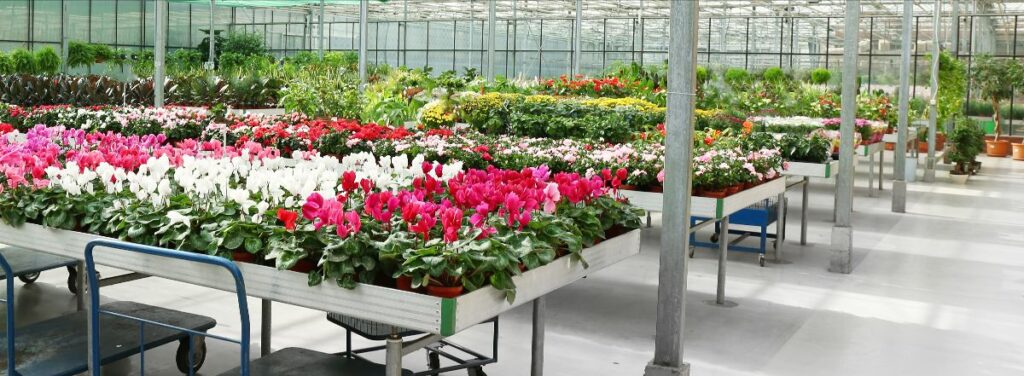
An irrigation system in place with a controller and various zones for automatic watering can be very helpful in ensuring the thorough, uniform watering of each plant, both during the week and over the weekends. I’m sure that those of you that have an automatic system in place would not trade it for the world. These systems provide proper watering when needed and allow for more free time that was once spent holding a watering wand on Sunday afternoons. Chances are that those Sunday waterings are more of a “keeping things alive” routine than a disciplined focus for the well-being of the plants.
These systems are cost-effective in so many ways. If set up correctly, fertilizer can be dosed with each watering to best meet the crops’ nutritional requirements. This will in turn produce a better end crop with less incidence of disease which is often the result of compromised growing practices. All this while your weekends are spent at home rather than in the greenhouse.
These systems do require a bit of thought to set up and schedule which will have to be tweaked week by week as weather and plant maturity change over the course of the crop. One must still monitor the plants, especially making sure each morning that no dry spots exist which would indicate a clogged sprinkler or even a failed solenoid. Other than cleaning the filters, watching for clogged sprinklers or drip tubes, and just making sure someone doesn’t accidentally unplug the controller, these systems are relatively care-free. As with anything “automatic”, some oversight is necessary to make sure all is as it should be.
If you have any questions or concerns about an existing system or are interested in setting one up for your greenhouse, please do not hesitate to reach out as I would be glad to help you design as system that would work exactly as needed for your greenhouse. Growing better crops with less time in the greenhouse will be the end-result.
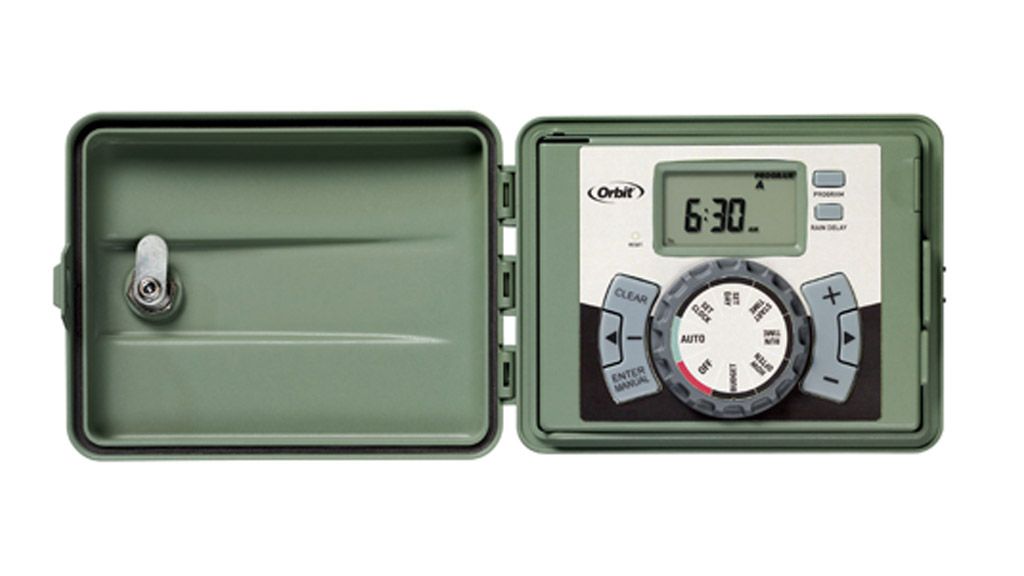
Disclaimer!
If you’re doing something different in your greenhouse than is shared above and all is going well, please don’t change. Perhaps modify, experiment and consider but be cautious before changing a good thing. Successful growing is the result of many, many variables. Some we have control over and some we don’t. The above is only meant as a guide or checklist prior to the upcoming growing season.
Questions/Concerns?
If you need help or elaboration on any of the above topics, please feel free to contact us. If you need a source for or advice on annuals, perennials, pH or EC meters, soil or anything else, I can help you with that as well.
Happy Growing!

Mike Hellmann
Plants and Cuttings Manager
P.S. Curious about my background and how I got to Hummert? You can find out more here.

One Response